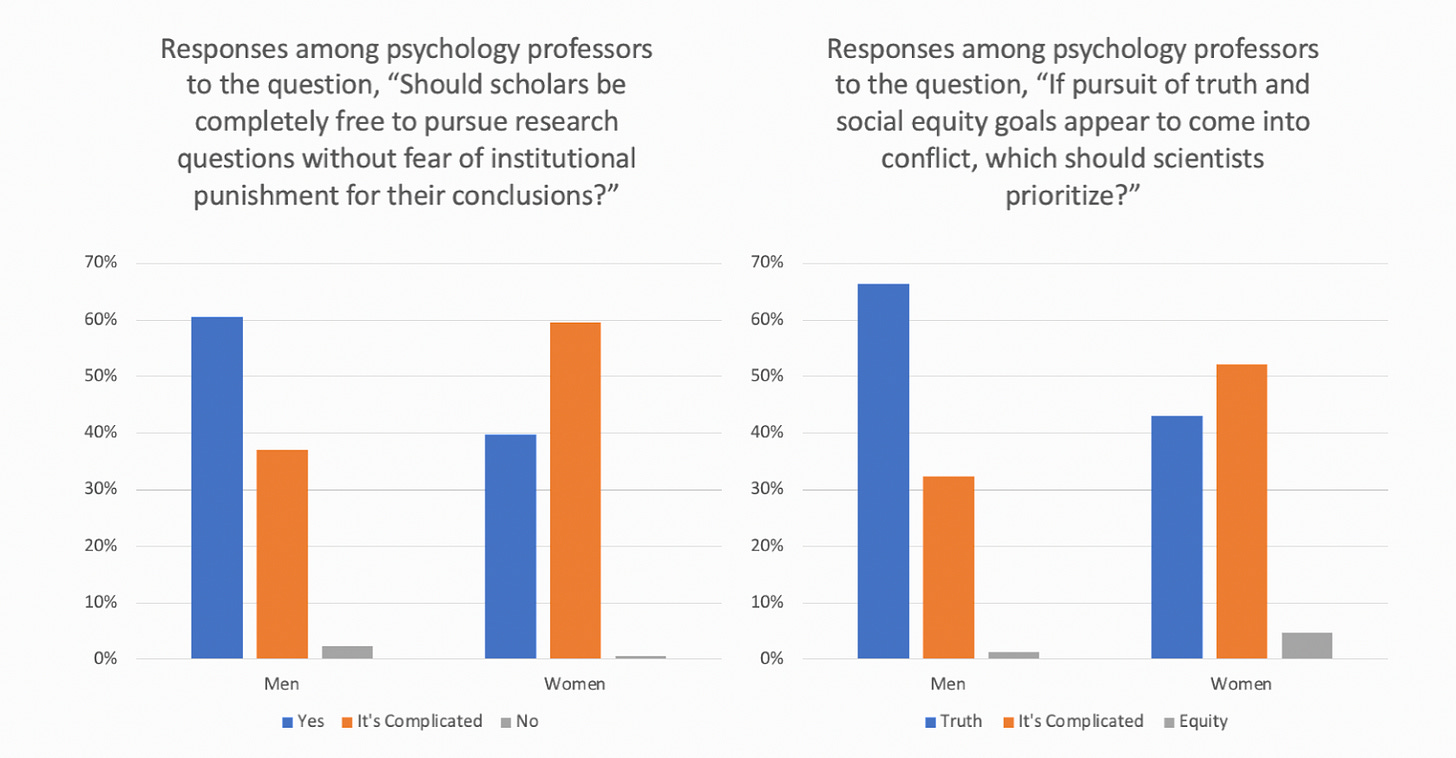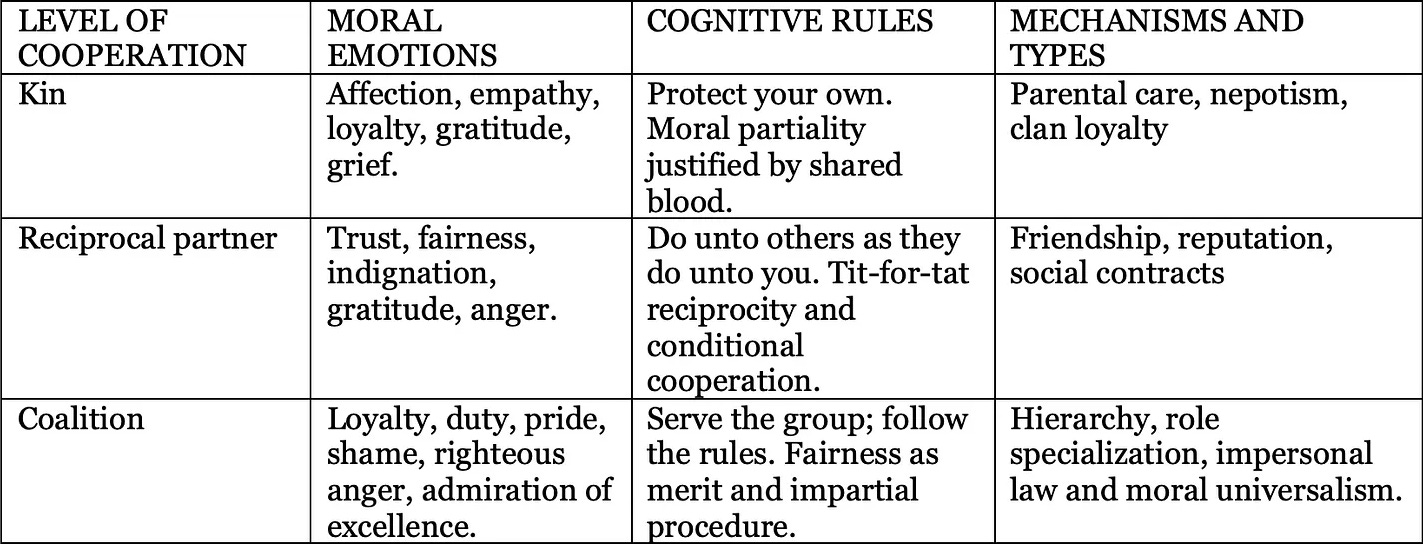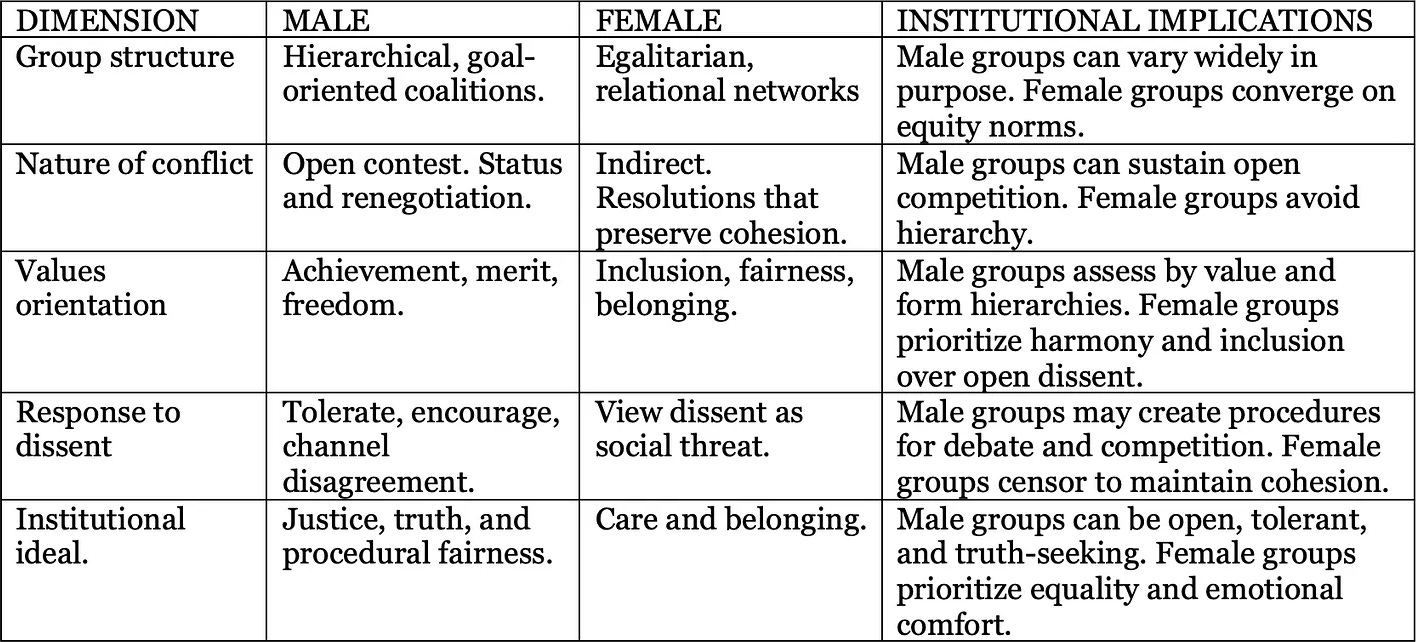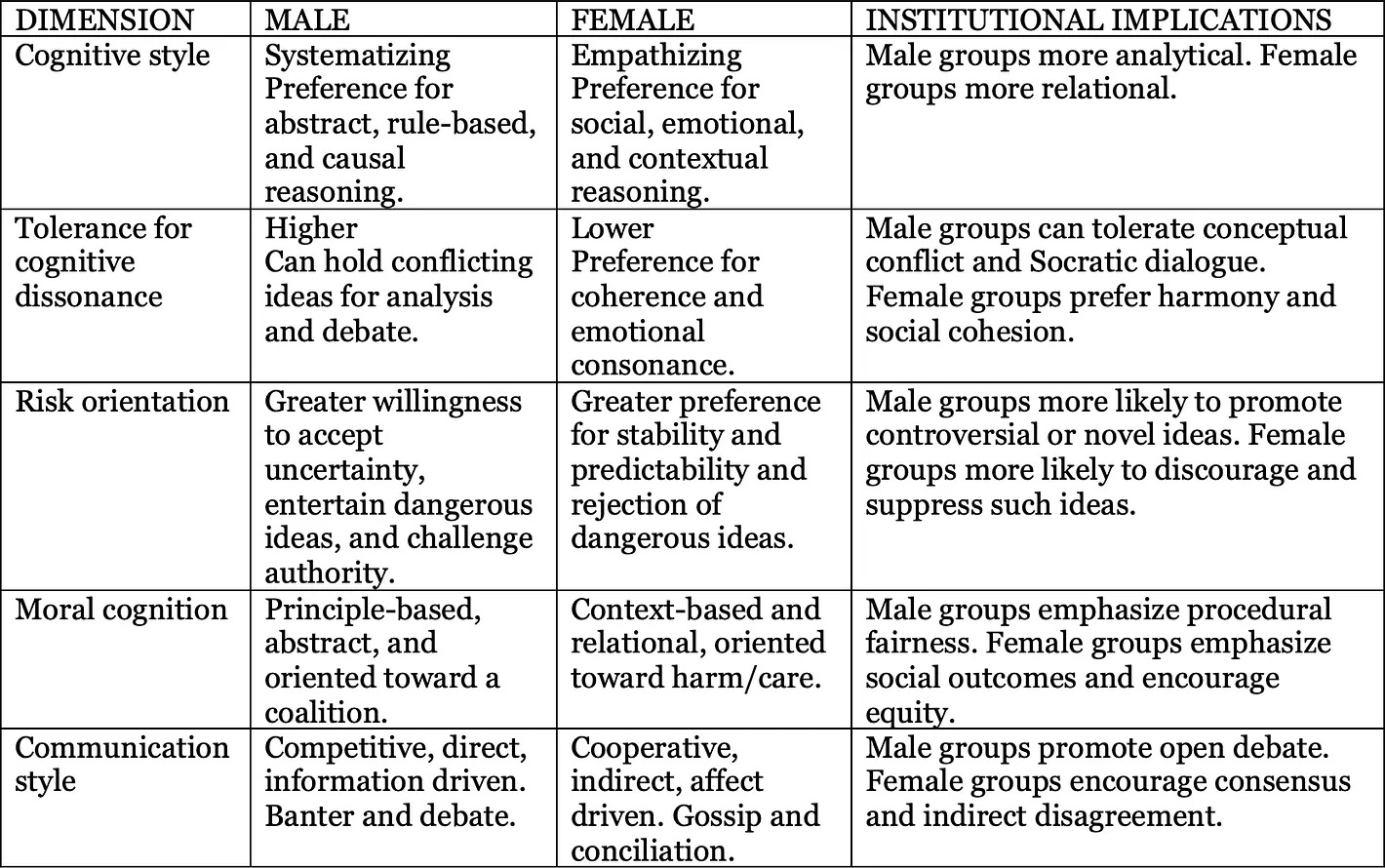What Helen Andrews' critics get wrong
The feminization of institutions is a real concern.
Written by Bo Winegard.
In a piece criticising Helen Andrews’ recent article contending that feminization is degrading institutions like academia and the law, David French made the following argument.1
Consider this remarkable assertion: “Cancel culture is simply what women do whenever there are enough of them in a given organization or field.” How can that claim survive even the most cursory historical analysis? Countless male-led revolutionary and radical movements have featured denunciations and purges, secret informants and struggle sessions.
It was not squadrons of women who guillotined dissenters during the French Revolution.
Even in the present day, the MAGA movement engages in cancel culture with remarkable vigor. And those cancellations are intended to protect the feelings — yes, the feelings — of the men on the right.
This is true enough, if a bit polemical. Just because men can create liberal, truth-seeking institutions does not mean that they will. History is replete with examples of male coalitions that crushed dissent and enthroned delusion, their convictions as fanatical and self-deceived as any the modern academy could devise.
What history is not replete with, however, are examples of female coalitions devoted to truth or impartial justice.2 Men can create such institutions; women cannot.3
Evolutionary history
Women have excelled in domains of care and cohesion, tempering the male proclivity for violence and conflict. But they have not created autonomous truth-seeking institutions.
Their social predispositions, inclined toward equity and emotional harmony, tend to discourage the competition, the audacity, the autonomy and the impartiality that such institutions require. Thus, as women’s presence in the academy, politics and cultural organizations more broadly has grown, those institutions have changed — becoming more solicitous of equity, inclusion and affirmation, and less protective of merit, competition and conflict. This is most evident in the academy, which has long since strayed from the telos of truth. But it is becoming more visible in other institutions as well.
To a keen observer of human nature, this transformation is predictable and perhaps inevitable because men and women differ not only in body but in mind. Sex differences, although influenced by culture, are partly innate. The issue is not the behavior of any particular man or woman, since the sexes overlap in traits and tendencies. It is only in the collective that the different proclivities of men and women that become pronounced. One woman’s traits may be as unpredictable as ripples on a pond, but women as a group are as predictable as a river’s current. They move in one direction, molding the institutions they enter to their social logic of equity, care and consensus, creating a gradual shift from hierarchy and competition toward harmony and inclusion.
What Tolstoy said about happy families is also true of women’s social groups and institutions. They are all alike. Because women were not selected to form large, goal-oriented coalitions.
The evolutionary pressures they faced selected instead for the maintenance of harmony within families and small networks, not the pursuit of large, coordinated projects. Men’s social groups and institutions, by contrast, can vary from intolerant and fanatical to liberal and truth-seeking. This capacity for variation arises because men, unlike women, were selected for cooperation in hierarchical pursuits, e.g., for building, hunting, warring. Male groups evolved to tolerate conflict and inequality in service to a shared goal, whereas female groups evolved to promote cohesion by minimizing both.
The key to understanding the effects of women’s increasing prominence in modern institutions thus lies in understanding the evolution of sex differences, especially sex differences in cooperation.
Among primates, humans are uniquely cooperative, capable of organizing collective behavior across several distinct levels, each governed by its own moral intuitions and social norms: kinship, reciprocal partnership and coalitional coordination. These levels of cooperation arose as the social mind expanded from the parochial bonds of family to the cosmopolitan bonds of large coalitions.
The first level of cooperation, kin-based cooperation, is the oldest and most intuitive form of sociality. Consequently, it is found in many extant species, from ducks to deer to humans. Parents protect offspring; siblings share food; families defend territory. Shared genes create incentives for coordination and sacrifice. The moral sentiments that promote this kind of cooperation are partial and emotionally charged. Affection, loyalty, empathy and obligation to one’s own. That these moral emotions remain potent can be seen in the difficulty of eradicating nepotism. Even in modern bureaucracies, kinship often trumps merit.
The second level is reciprocal partnership, cooperation between non-kin in mutually beneficial exchanges. This is more complicated than kin relationships because it requires a calculation of partner value and a running tally of reciprocity. Two people hunt together and share the resulting kill. Or one person collects food and shares with the other, expecting repayment in the future. These relationships are mutualistic and flexible, oriented around trust, fairness and reputation. The relevant moral sentiments are gratitude and anger, and the moral sense is reciprocity.
The third and most abstract level of cooperation is coalitional cooperation, the coordination of large groups of non-kin unified by a shared goal. This form of social organization underlies every complex institution, from the army to the university. And it is here that sex differences are the most pronounced and consequential.
Across evolutionary history, men were selected for precisely this kind of large-scale coordination because groups of men who could organize effectively, for hunting, defense, or warfare, had fitness advantages over those that could not. While military buffs emphasize and obsesses over strategy, the primary predictor of success in battle is numbers. The larger group generally prevails. And losing in such a battle often resulted in death or slavery, two outcomes which, needless to say, are not evolutionarily propitious.
Success for men in forming large coalitions required mechanisms for ranking, enforcing impartial rules, and harnessing the power of individual talent for group benefit. The solution to this last problem was a status-exchange system. A skilled hunter or fighter earned status from his group, and his group benefited from his skills. The mind shaped by these selective pressures valued hierarchy, fairness understood as merit, a disciplined emotional stoicism and impartiality, the moral foundations of what would later become meritocracy, law, and science.
Women, in contrast, were primarily selected for kin and reciprocal levels of cooperation, the care of children, maintenance of family, and management of reputation in smaller social networks.4 Unlike men, they rarely engaged in coalitional combat. Thus their moral mind was oriented not toward impartiality of rule but to empathy and concern for the vulnerable. Whereas men developed a coalitional morality that emphasized duty, loyalty to the group, and the subordination of emotion to function, women developed a relational morality emphasizing care, equity, and emotional cohesion.
Sigmund Freud’s controversial assertion that women possessed a weaker superego than men and thus a deficient sense of morality may be interpreted less as manifestation of misogyny than as an accurate observation of these different moral sensibilities.5 Men’s moral predispositions evolved around the creation and enforcement of rules within large coalitions, whereas women’s evolved around the preservation of peace within small groups and dyads.
These different evolutionary paths produced different innate cognitive and emotional tendencies relevant to modern institutions. On average, men are more systemizing, inclined to reason about objects, abstractions and formal rules. Women are more empathizing, inclined to contemplate and ruminate about persons and feelings. Men are more tolerant of risk, pursue status more openly and aggressively, and tolerate competition more easily, often exhilarating in the clash of arms or ideas. Women exhibit stronger preferences for security, stability and social harmony, often discouraging dissent and debate.
Put crudely, men seek more variance. Women seek more consensus. Neither bundle of predispositions is superior or inferior. Like a tool, they work well to solve the problems for which they were designed. However, they often fail at problems for which they were not designed. Just as a baseball mitt is great for catching fly balls but bad for typing, so too a tendency to favor equity is great for small social groups but bad for an army.
This evolutionary history explains why male and female groups are so different in character. Men’s groups are hierarchical, rule-based and goal directed. Fight this battle. Hunt these animals. Build this structure. Women’s groups are egalitarian, relational and process directed. Tend to this child. Solve this conflict. Maintain emotional well-being. These differences are not the outcome of patriarchy or invidious stereotypes, but of evolved emotional and cognitive tendencies. And they are, as far as I can tell, inevitable.
The upshot of this is that men are better than women at creating and maintaining hierarchical organizations and impartial norms and rules, and thus better at creating and maintaining many of the institutions vital to modern civilization: the academy, the army, the legal system.
Hyperbole is unnecessary. women are not destroying civilization. And men, being violent and competitive creatures, are perfectly capable of creating a cancel culture every bit as repressive and intolerant as women. Indeed, under the wrong conditions, men are better than woman at building ideological machines that crush dissent, sending dissidents not to the HR office, but to the scaffold or the Gulag.
Yet under the right conditions, men have also built the only institutions that pursued truth and justice for their own sake: the academy, the court of law, the laboratory, the free press. These arose from a peculiar form of cooperation unique to men: hierarchical, competitive, meritocratic, and oriented toward an abstract goal.
A look at the data
As women have entered traditionally male institutions in ever greater numbers, those institutions have changed, sometimes gradually, sometimes abruptly, and potentially for the worse. This should not be understood as denigrating women, who are undoubtedly superior to men in many domains of life. Rather, it should be understood as a common-sense recognition that largely male-created institutions often flourish best when dominated by men.
As a case study, consider the academy, whose sex ratios have changed dramatically over the past half-century. In 1970, women earned fewer than ten percent of doctoral degrees in the United States. That share rose steadily, reaching parity with men by 2005. Today, women earn the majority of new doctorates. The same pattern appears across much of the West. As student populations feminize, so too do faculties and professoriates. Women already outnumber men among post-secondary faculty and are on track to surpass them among professors as well. Put simply, the modern university is becoming a feminized institution.6
It is not a coincidence that over this same period, the academy has drifted and perhaps accelerated away from its traditional lodestar, the pursuit of truth. In its place has risen a new lodestar: social justice, equity, and the emotional safety of students and staff. In other words, extreme progressivism. Outside of the academy, many have pushed back against this species of progressivism. But inside, things are as bleak as ever, with prominent journals encouraging authors to include “citation diversity statements”. In place of meritocracy, we get a communism of victimhood. From each according to their privilege; to each according to their intersectionality.
This is not a coincidence because women prioritize different values in academia. Copious data, both self-report and observational, support this. Some highlights follow.
In a 2017 YouGov survey of US adults on issues related to free speech and tolerance on college campuses, men were more likely to defend controversial ideas and controversial speakers than women. 56% of men said that students should not be protected from controversial ideas, whereas 64% of women said they should. And a majority of men supported the right of nine out of 11 controversial guests to speak at a campus, whereas a majority of women opposed all 11.
In a 2021 CSPI survey of academics and PhD students at universities in the US, Britain and Canada, men were more likely to support intellectually foundational texts over diversity quotas than women. Only 24–34% of men supported diversity quotas, compared to 44-66% of women.
In a 2018 Knight Foundation survey of full-time college students on issues related to free expression and DEI, men were more likely to support free speech over inclusion than women. 71% of men said free speech was more important, whereas 59% of women said promoting inclusion was.
In a 2020 paper by Geher and colleagues, US academics were asked to allocate points across different academic priorities. Men allocated more to advancing knowledge, academic rigor and academic freedom. Women allocated more to social justice and emotional wellbeing.
In a 2024 paper reporting results from a survey of psychology professors, men were more likely to support academic freedom and open inquiry than women. The differences were large.

As Cory Clark and I summarized in an article on women in the academy:
The overall theme of these differences is that men are more committed than women to the pursuit of truth as the raison d’être of science, while women are more committed to various moral goals, such as equity, inclusion, and the protection of vulnerable groups … Put more simply, men are relatively more interested in advancing what is empirically correct, and women are relatively more interested in advancing what is morally desirable.
What is true of the academy is true of other institutions. As women gain influence within them, those institutions tend to become more oriented toward equity and social justice and less protective of meritocracy and impartiality. In some settings, this may be a humane correction; in others, it may prove disastrous. Helen Andrews has expressed particular concern about the law; I am more concerned about science. Both are of course vital to the West.
As progressivism has spread through the media, the academy, and the professions, our ability to discuss sex differences honestly has declined. One can say that women are better than men, as President Obama once did, but to suggest that men might excel in some domains is to invite charges of misogyny. The result is that serious conversation about the feminization of Western institutions is nearly impossible.
Yet the fact remains that men and women are different, and those differences have consequences for the institutions they shape.
I do not believe women will destroy the West nor that cancel culture is simply what happens when women gain power. But I do believe that men, on average, are better suited to creating and sustaining certain types of institutions, namely those that prize hierarchy, competition and truth. And as those institutions continue to feminize, their traditional virtues will continue to erode. We should value the unique role women play in civilization, but we should not pretend that their increasing prominence in traditionally male institutions is an unalloyed good.
Patriarchy worked for a long, long time. It may have been wrong about some things, but it’s unlikely that it was wrong about everything.
Bo Winegard is an Editor of Aporia.
Consider supporting Aporia with a paid subscription:
You can also follow us on Twitter.
Of course, a perfectly fair objection is that women were, for much of history, excluded from domains in which large, autonomous institutions could be formed at all. Legal and then economic barriers made it nearly impossible for them. By the 1880s, however, women were forming their own voluntary associations, literary clubs, temperance unions, settlement houses and professional societies. These were often remarkably socially influential, but, to my knowledge, did not evolve into independent truth-seeking institutions like the academy, the press,or the law. Their moral orientation remained relational and reformist, often focused on education and social improvement, rather than epistemic or meritocratic. Nevertheless, I accept this criticism. Women lacked the opportunity for centuries. Thus it is not surprising that for most of history they formed no such institutions. Their absence is not dispositive, but is of evidentiary value.
I admit that this is a provocative claim. But I think it true. Women can form groups that seek truth and justice impartially. But I do not think they can build and maintain large institutions that do so. On the other hand, most men cannot either.
Of course, women do interact in large social groups as well, perhaps to spread and receive information about competitors.
Freud wrote, “We must not allow ourselves to be deflected from such conclusions by the denials of the feminists, who are anxious to force us to regard the two sexes as completely equal in position and worth.” We may agree with him that we should not allow the denials of feminists (or progressive academics) to deter us from the truth, but we would probably change his language. Men and women are equal in moral worth, but different in traits and tendencies. In some domains, men are superior to women; and in others, women are superior to men. This of course is so obvious that it should hardly need mentioning. Alas, the obvious has been under assault by the academy for many years now.
Importantly, it is likely that as an intuition becomes feminized it selects for effeminate men and incentivizes effeminate behavior. The men who do not comply are expelled or marginalized.







I'm going through this at my university. Our department is mostly female, and the infantilization is beyond my comprehension. Recently a gaggle complained to the director that they 'felt belittled' in my class because I hinted that perhaps other (marginalized!) students could speak too. One has a thick accent, and in asking her to repeat herself several times, I offered that it was the accent -- this is an ESL writing course, and normally I can understand the most convoluted things, but this accent really threw me.
Anyway, they complained, and their FEELINGS were taken far too seriously. I was advised to NOT CHALLENGE them. Making them feel CHALLENGED makes them "anxious and uncomfortable" and despite the fact that the students are in the course to improve their English language skills, I am not to mention an accent that everyone can hear either...also, I'm apparently the only professor ever who was advised not to tell the students that I'm a writer, (teaching a writing class) because that can make them feel intimidated.
I felt like I was on a different planet.
During the racial hysteria of 2021, I was called a "racist" for not exempting a student from my writing course based on objective analysis of her writing samples. While trying to explain this to her, she started screaming at me -- which was fine with HR because FEELINGS. She then ran to HR to complain. I had also steel manned a feminist work of art, and critiqued it. The critique made me a 'racist.'
In exiting the meeting with HR, I was advised to find witnesses to support that I am not a "racist." When I asked what evidence the student supplied that I am one (it was all appeals to emotion) the HR biddy replied: She doesn't have to provide evidence. All that matters is the way you made her feel.
I've been toying with responding to the director with that statement saying, So the students feel 'anxious and uncomfortable' because I'm doing run of the mill classroom management, yet I'm not going to feel "anxious and uncomfortable" in an institution where anyone's feelings can trump not only my feelings, but the evidence to support that I was just doing my job.
There are many valid points in this article by @Aporia but the analysis oversimplifies the strengths of women, while underestimating the destructive potential of their(our) shortcomings. Female groups are treated as cooperative and harmony-seeking while ignoring what is known about intrasexual competition, status anxiety, and reputation management. Female hierarchies are not absent, only enforced differently. What looks like peace is forced consensus imposed by the more dominant women of the group.
Women claim to want equity, justice, and integrity but lack the institutional capacity to make that happen. In practice, the result is conformity, social punishment for dissent, and the policing of thought and behaviour. In female-dominated environments such as nursing, aggression runs both laterally and vertically. Hierarchies are maintained through surveillance, exclusion, and reputation attacks rather than open disagreement.
It might be that without a strong structural framework provided in more male-led systems, institutions lose coherence. As structure weakens, competition and insecurity appear to intensify, and the same social dynamics seen in informal female groups begin to surface in professional contexts.
Anuradha Pandey writing offers a useful reality check on this pattern, showing how the female-dominant professional managerial class has accelerated institutional decline under the banner of empathy and inclusion, when it’s anything but.